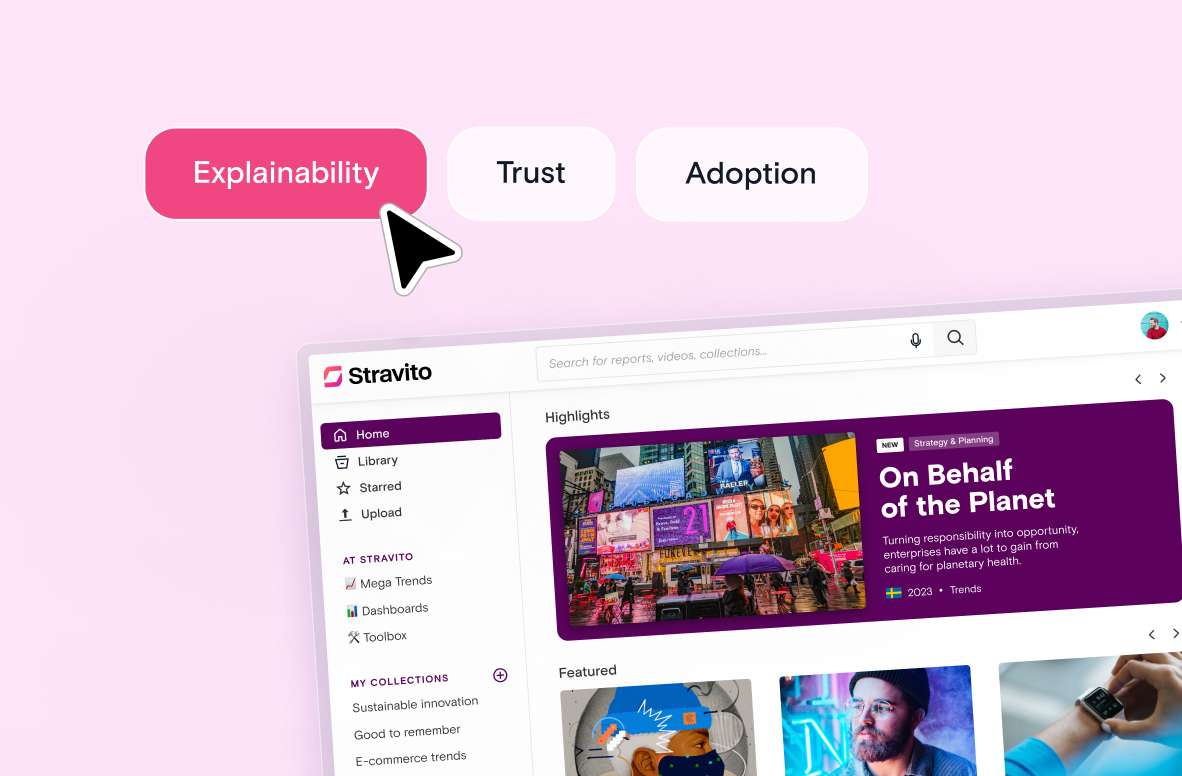Your research team is producing valuable insights. But if stakeholders can’t find them, it’s like the work never happened.
This is where most research repositories fall short. They store the data, but stop there.
No help with discovery. No support for sharing. No way to track what’s being used or ignored.
In 2025, your UXR team needs more than a place to keep files.
You need a research repository that helps you scale your impact. One that surfaces key insights, connects past projects, and delivers findings where they matter most.
TL;DR: What to look for in a modern UX research repository
We know you’re busy. Here are the key takeaways:
- Many research repositories fall short because they only focus on storage.
- A good repository tool should help teams find, explore, and share research insights.
- Look for features like intelligent search, user analytics, and discovery feeds.
- Support for collaboration tools, access control, and automated tagging is essential.
- A modern platform should turn existing research into action, not shelfware.
UX research teams aren’t struggling to do the work. They’re struggling to make their work usable.
Without the right research repository, insights get buried, studies get repeated, and no one has time to dig through old reports.
Here’s why most tools fall short and what a better solution looks like.
Why traditional research repositories fall short today
Most research repositories were built to store data. That’s it.
They don’t help your team find past research. They don’t connect insights across projects. And they don’t make it easy to share what matters with stakeholders.
When that happens, three things start to break down:
1. Insights get buried
User research reports sit untouched in folders. Valuable research findings are hidden in old slide decks. Team members don’t know what exists or where to look.
2. Research gets repeated
Without a way to access research data quickly, teams redo the same research study again and again. It slows down product timelines and wastes budget.
3. Impact gets lost
If research insights don’t reach product managers, marketers, and other stakeholders, they can’t shape decisions. Your research efforts go unseen and unused.
A good user research repository should act like a launchpad, not a graveyard. It should help your team:
- Find existing research fast
- Connect qualitative and quantitative data
- Share key insights across teams
- Avoid duplication and knowledge loss
- Turn all your research data into real decisions
And none of that happens without great search. Let’s start there.
Make research findable with AI-powered search
If your team can’t find past research, it might as well not exist.
Many UX research teams rely on shared drives or generic tools to store research materials. But these platforms weren’t built to handle the complexity of user research data.
They lack the features your team needs to search, filter, and surface relevant insights.
A strong user research repository needs to make search effortless, even across unstructured data, raw findings, or multiple formats.
Here’s what to look for:
1. Natural language search
Team members should be able to ask questions in plain language. A good repository tool should return the right research reports, even if the exact wording doesn’t match.
2. AI assistance
Stravito’s research repository tools go one step further. The built-in AI Assistant helps you explore topics, summarize reports, and ask follow-up questions. You don’t just search, you discover.
3. Ontology and synonyms
Great search includes smart matching. If you search for “sustainability,” you should also see research tagged under “eco-friendly” or “green behavior.”
This is where many generic repository platforms fall short.
Instead of scrolling through folders or pinging a user researcher for help, your stakeholders can find answers themselves.
Then, your team spends less time tracking down past research and more time conducting new research.
That’s where Stravito’s AI Assistant comes in.
Explore vs. Focus: How Stravito’s AI Assistant Delivers on Search
In her in-depth review of Stravito, UX research expert Emily DiLeo highlighted the importance of supporting both discovery and deep analysis in a modern research repository.
Her experience shows how Stravito’s AI Assistant goes beyond surface-level search to give teams quick access to meaningful insights without sifting through dozens of slides.
When a user enters a query, the platform offers two clear options:
- Explore mode helps you look broadly across your user research repository, surfacing related research projects, past user interviews, and common themes across your organization.
- Focus mode drills into specific research reports and highlights the most relevant insights tied to your question.
Emily noted how simple it was to get started. For example, entering the question:
“Do people like to recycle?”
The Assistant returned a clear summary, followed by a list of supporting sources and useful follow-up questions like:
- What prevents people from recycling?
- Do younger people recycle more?
- How does behavior vary by country?
These prompts guide users to go deeper without needing to manually dig through raw data, research findings, or reports.
Stravito also flags older content with contextual notes like:
“Possibly outdated. Check the Year tag.”
This small detail helps ensure that future research is based on relevant data, building trust with both researchers and stakeholders.
The experience combines smart summarization, AI-powered recommendations, and natural language interaction.
This is all designed to make research insights more discoverable, reusable, and trusted.
Stravito doesn’t just store research data. It helps your team access it, question it, and act on it.
Of course, even the smartest search isn’t helpful if people don’t know what to look for. That’s why discovery matters just as much, especially when teams need to uncover insights they didn’t know existed.
Drive discovery with smarter content surfacing
Search only works when someone knows what to ask.
The best UX research repository also helps people discover insights they didn’t expect to find.
Discovery happens when a stakeholder stumbles upon something useful.
It might be raw data from user interviews, a theme from past research, or a trend hidden in qualitative and quantitative data.
These moments are powerful. They spark new ideas, guide future research, and support user-centric decisions.
Discovery also keeps people engaged. When team members find valuable insights without searching, they start to trust the platform. They come back more often. They use it more deeply.
A good user research repository should support that behavior with the right tools:
- Insights feeds. Let users follow topics and see new research data as it’s published.
- Smart suggestions. Recommend related research reports and studies while someone views a document.
- Curated collections. Group research findings, raw data, and analysis around a goal or feature.
- AI prompts. Suggest follow-up questions based on what the user is exploring.
These features help your research team move beyond storing data. They help you connect all your research data, support collaboration tools, and drive visibility with multiple stakeholders.
A good research repository doesn’t just organize research. It helps you use it.
But discovery alone won’t change behavior.
Your UX research repository also needs to engage stakeholders in ways that feel easy, personal, and useful. Let’s explore how.
Keep stakeholders engaged with curated insight delivery
It’s not enough to store research. Your user research repository needs to deliver it.
Even when research findings are well-documented, stakeholders often miss them. Product managers are buried in dashboards.
Marketers rely on their own tools. Busy teams don’t have time to dig through folders or read long reports.
That’s why engagement matters.
A good UX research repository doesn’t wait for people to search. It brings the right insights to the right people at the right time.
Here’s how the best repository platforms support stakeholder engagement:
Personal insights feeds
Let team members choose what topics matter to them. New research projects and updates appear automatically.
Highlights and featured content
Use research repository tools to spotlight key insights on the homepage.
Easy sharing
Let users send research reports or curated collections via Slack, Teams, or email. No log-in hoops.
In-platform messaging
Allow comments and tags within the tool so stakeholders can ask questions or request further research.
Collections and scrapbooks
Give researchers a way to package insights from multiple projects into one place. Share that with others to tell a focused story.
These features make knowledge sharing simple. They help your research team reach multiple stakeholders without extra manual work.
And they help your research repository act more like a publishing tool and less like a storage drive.
What to dig deeper? Check out our webinar on how to create an engaging UX research repository in 2025.
Of course, none of this matters if you can’t track what’s working. That’s where analytics come in.
Use analytics to drive adoption and prove impact
You can’t improve what you can’t measure.
Many research teams spend hours uploading research reports and curating insights, only to wonder if anyone actually saw them.
This is the reality for a lot of UX research teams. You do the work, but you don’t always know what happens next.
Good analytics change that.
A strong research repository gives you more than usage stats. It shows how your insights are being shared, reused, and applied across the organization.
Look for repository features that help your team:
Track content performance
See which research studies are being viewed, by whom, and how often.
Monitor upload activity
Know whether team members are sharing their own research and contributing regularly.
Spot power users
Identify the people who engage often and invite them to help champion adoption.
Segment by team or role
Understand which departments are using which types of research insights.
Measure engagement over time
Prove the long-term value of your research repository tools with clear trends and benchmarks.
This kind of data is essential for building a research roadmap, justifying budget, and making research more visible across teams.
If your research efforts feel stuck in a black box, you’re not alone.
But with the right analytics, your team can shift from guessing to knowing and make smarter decisions about what research to invest in next.
Want to learn how real teams are improving research visibility? Watch what 200 UX professionals had to say about research best practices.
Now that we’ve covered the core capabilities, let’s zoom out.
What does a truly modern UX research repository look like in practice?
How to build the research repository your UXR team needs
Storing research is not enough. Your UX research team needs a system that helps people find insights, reuse past work, and share findings across the business.
Here’s how to set up a user research repository that works in practice.
Step 1: Bring all your research into one place
Start by collecting everything your research team has created or gathered.
Include:
- Research reports and presentations
- Raw data from user interviews and surveys
- Research materials like videos, quotes, and charts
- Qualitative and quantitative data from past projects
- Third-party research from vendors
With a dedicated tool like Stravito, you can:
- Sync research data from tools like Google Drive or Dropbox
- Upload files from existing research platforms or research vendors
- Store all your research data in one secure place
This creates a single source of truth for your team and stakeholders.
Step 2: Organize with smart metadata, not folders
Folders break fast. A good UX research repository needs a structure that grows with your team.
Use metadata and smart tags to:
- Group research projects by product, region, or audience
- Label content by research methodology or file type
- Surface key insights across different research efforts
Stravito automatically tags and categorizes content, so you spend less time on admin and more time sharing insights.
Step 3: Make it easy to find research insights
Stakeholders should not have to dig for information.
Use research repository tools that offer:
- Natural language search
- AI-powered summaries and follow-up suggestions
- Synonym matching and topic clustering
Stravito helps users search by question, topic, or need. That means product managers and other team members can access research data without calling in a researcher.
Step 4: Create collections people will actually use
Once your research data is findable, make it easier to share.
Help your UX research team:
- Curate themed Collections by topic, market, or project
- Build Scrapbooks that combine highlights from different studies
- Include atomic research snippets alongside full research studies
This makes research findings easy to share with multiple stakeholders in the right format for their role.
Step 5: Deliver insights where people already work
Don't make teams come to the repository. Bring the insights to them.
Look for repository platform features like:
- Personalized feeds by topic or role
- Research highlights on the homepage
- Easy link sharing via Slack, Teams, or email
- In-platform tagging and collaboration tools
These features help you democratize research without adding to your workload.
Step 6: Track usage and improve over time
Your user research platform should show you what’s working.
Use built-in analytics to:
- See which research reports are viewed most
- Identify frequent users and active contributors
- Track upload activity across the research team
- Measure adoption by department or role
This helps you prioritize future research and improve how you share findings.
Step 7: Keep your system flexible and scalable
Research changes fast. Your repository tool should adapt.
Choose a research repository software that:
- Supports both qualitative and quantitative data
- Handles structured and unstructured data
- Works for global and local teams
- It’s easy to maintain without extra admin work
Stravito is built to scale with your UX research team. Whether you are storing detailed findings or running fast research projects, it helps your team stay aligned and productive.
The research repository your team actually uses
If your research repository just stores information, it’s not doing enough.
In 2025, UX research teams need a dedicated tool that helps them:
- Access existing research and avoid repeated work
- Analyze data across past projects and formats
- Share user research insights with product managers, marketers, and more
- Track engagement, adoption, and real-world impact
- Build a system that scales with their research roadmap
Stravito was built to meet those needs. It’s a specialized user research platform that helps your team make research accessible, visible, and used without extra admin or IT support.
Whether you're organizing raw data, sharing key insights, or collaborating with multiple stakeholders, Stravito helps you move from knowledge storage to insight activation.
Next steps
If you're:
- Drowning in research reports
- Struggling to connect team members with past research
- Repeating the same research study again and again
- Trying to scale a user-centered approach across a large organization
Then it’s time to rethink how your research repository works.
Request a personalized demo to see how Stravito can help your UX research team activate all your research data faster, easier, and with less effort.
FAQs
What is a user research repository, and why do teams need one?
A user research repository is a centralized platform that helps research teams store, organize, and share all their research data.
This includes research reports, user interviews, qualitative and quantitative data, raw data, and research findings from past projects.
The right repository tool makes it easy to access research data, avoid duplicate research efforts, and deliver insights to product managers and other stakeholders.
A good research repository supports collaboration, scales with your team, and helps democratize research across the business.
How does a UX research repository support better decision-making?
A modern UX research repository surfaces key insights from across multiple research projects.
It connects unstructured data, past research studies, and existing research into one searchable system.
This allows product teams to quickly analyze data, find relevant research materials, and make user-centric decisions based on both qualitative and quantitative data.
With tools like Stravito, research teams can create curated Collections, highlight detailed findings, and make all their research data visible to the right people at the right time.
What features should I look for in research repository software
The best research repository software includes features like:
- Natural language search
- AI-powered summaries and discovery tools
- Personalized insights feeds
- Smart tagging and metadata
- Collections and scrapbooks for research packaging
- Usage analytics and access tracking
- Easy sharing across collaboration tools like Slack or Teams
A good research repository acts as a specialized tool for storing, analyzing, and distributing user research data across your organization.
For a breakdown, read our full comparison guide of the best UX research repository tools available today.
How does Stravito compare to traditional repository platforms?
Many research repositories fail because they’re built for storage, not discovery. Stravito, on the other hand, is purpose-built to democratize and make UX Research insights actionable for the business.
It supports full research studies and dedicated collections of studies, making it easy to upload, tag, organize, and build stories around research insights, making research easy to consume and apply.
While it doesn’t follow a strict atomic research model, it helps teams find and action key insights from past research with ease.
Stravito also offers powerful search and discovery tools, so teams can quickly access existing data and share findings with stakeholders.
Can a user research platform reduce repeated research?
Yes. One of the main reasons teams repeat the same research is that they cannot find existing work.
A dedicated user research repository helps store data, structure it clearly, and make it easily accessible later.
With search, tagging, and topic-based navigation, teams can find relevant research efforts from past projects and avoid rerunning the same research study.
That saves time, reduces cost, and increases the ROI of your user research.




